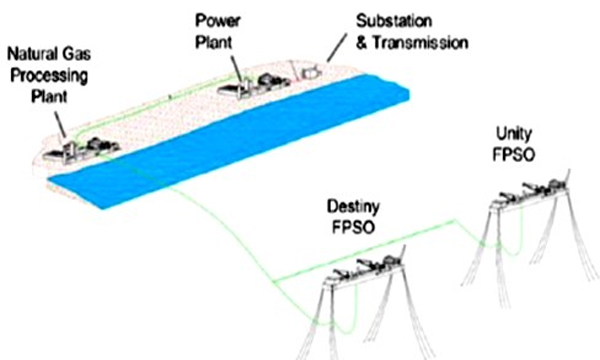
Davina Bagot, Kaieteur News
GEORGETOWN
EnergiesNet.com 10 12 2022
Even though the Environmental Protection Agency (EPA) is yet to give clearance to the Gas-to-Energy (GTE) project, ExxonMobil said it has started construction of the pipeline about six months ago and is expected to deliver gas to the government in keeping with its 20224 timeline.
ExxonMobil’s Gas-to-Energy Project Manager, Friedrich Krispin made the announcement last Wednesday while providing an update on the venture at the Guyana Basins Summit. Krispin told conference delegates comprised mostly of foreign investors that the construction of the pipeline is expected to take three years, as outlined in the company’s Environmental Impact Assessment.

On this note, he pointed out, “that clock was started about six months ago or so when we decided to invest in the project and then therefore we are going to be targeting to complete the pipeline by the end of 2024.” Krispin added that government’s 300 megawatt power plant should also be completed by 2024, while the Natural Gas Liquids (NGL) facility should come on stream by the third or fourth quarter of 2025.
The Project Manager was keen to point out, “It’s an aggressive schedule but it’s one that we are committed to, to meet our objectives.” He went on to explain that he is “just thrilled” to be in Guyana and be part of the project simply owing to the significance it has for the country, its development of the economy and improvement of lives in communities. According to him, the project is “really important to us at ExxonMobil. I’ll give you just a little personal punch, I have been with ExxonMobil for 35 years, I have spent my life looking for opportunities of making money for the shareholders, saving money in capital projects, etcetera but today I’m here to make sure we improve the lives of the people of Guyana.”
The Gas-to-Energy project will encompass three major aspects, that is, the pipeline to transport the gas to Wales; the Natural Gas Liquids (NGL) facility that will treat and separate the gas and the power plant to generate the electricity. So far, Guyanese have been told that the pipeline aspect, which is being pursued by US oil major ExxonMobil, will cost around US$1.3 billion, while the other two facilities are expected to come in around US$700 million.
Notably, the contractor has not yet received the necessary approvals for the project but has started construction works.
In July, Exxon entered into an agreement with two companies to aid in the laying of the 190 kilometre pipeline. Subsea 7 and Van Oord were contracted to assist in the project management, engineering, and installation of the natural gas pipeline, with an associated shallow water portion and onshore approach making landfall to the west of the Demerara River, along the coast of Guyana. Subsea 7, according to its website, specialises in subsea engineering, construction and services mainly for the offshore energy industry. The company is registered in Luxembourg with its headquarters in London. Meanwhile, Royal Van Oord is a Dutch maritime contracting company that specialises in dredging, land reclamation and constructing man-made islands.
In early August, it was announced that the oil company gave out another contract, this time to Technip FMC, a United-Kingdom based firm that provides expertise for subsea and surface projects. According to reports, the company received a “significant” contract to provide engineering, procurement, construction and installation of subsea risers and pipelines for the Wales Gas-to-Energy venture. Though a cost was not attached, it must be noted that a significant contract for Technip FMC is one within the range of $75 million and $250 million. The full contract award will not be included in inbound orders until the project receives a final investment decision and government approvals.
The Environmental Protection Act Section 21(1) states that: “No person shall – (a) construct, alter, extend or replace any plant, structure, equipment, apparatus, mechanism, or thing that may discharge or from which may be discharged a contaminant into any part of the natural environment except under and in accordance with a construction permit issued by the Agency…” This therefore means that the operator is required to seek an environmental permit from the EPA before it rolls out any developmental project that can affect the environment.
kaieteurnewsonline.com 11 12 2022












